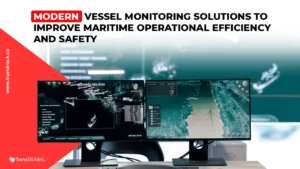Learn How to Fix Electric Power Steering and Why It Breaks!
Posted on January 10, 2025 by Nur Wachda Mihmidati

How to repair Electric Power Steering can be done in several ways. As vehicle steering becomes lighter and more responsive thanks to Electric Power Steering (EPS) technology, we also need to realize that its care and maintenance becomes more important. Vehicles equipped with EPS can provide great driving comfort, but when these systems encounter problems, proper steps are needed to fix them.
In this article, we will discuss in detail how to fix Electric Power Steering, providing a step-by-step guide that can be followed easily. Moreover, we will review how using the Vehicle Maintenance System from TransTRACK can simplify the repair and maintenance process. Let’s explore together how to troubleshoot your vehicle’s EPS and ensure every ride remains smooth and comfortable.
How to Fix Electric Power Steering
How to fix Electric Power Steering (EPS) can involve several steps depending on the source of the problem. However, keep in mind that fixing problems with the power steering system, including the EPS, can be potentially dangerous if not done properly. If you are unsure or have no experience in car repair, it is advisable to get help from a professional mechanic or automotive repair shop.
Here are some general steps how to fix Electric Power Steering:
How to Fix Electric Power Steering: 1. Check the Power Steering Fluid Level
Make sure the power steering fluid level is at the right level. Lack of fluid may cause problems with the system. Check the vehicle user manual for the appropriate fluid type and level.
How to Fix Electric Power Steering: 2. Check the Power Steering Belt
Make sure the power steering belt is in good condition. Loose or worn belts can cause problems with the power steering performance. If the belt looks loose or worn, consider replacing it.
How to Fix Electric Power Steering: 3. Check Sensors and Wires
The sensors and cables in the EPS system may have damage or weak connections. Check the cables connected to the EPS and make sure none are damaged or disconnected.
How to Fix Electric Power Steering: 4. Check the Fuse
Be sure to check the fuses associated with the EPS system. If one of the fuses burns out, replace it with a new one. However, it should be noted that a fuse that burns out frequently could be an indication of a deeper problem.
How to Fix Electric Power Steering: 5. Perform a Reset or Calibration
Some vehicles require calibration or readjustment of the EPS system after repair or replacement of certain components. Check the owner’s manual or technical instructions to see if these steps are required.
How to Fix Electric Power Steering: 6. Read Error Codes (DTCs)
Use the OBD-II scanner tool to read the error codes (DTCs) associated with the EPS system. This information can help identify a more specific source of the problem.
How to Fix Electric Power Steering: 7. Check Electronic Components
Check electronic components such as switches, relays, and the EPS control module. If there are signs of damage or wear, consider replacing them.
If you are unable to locate the source of the problem or if repairs are unsuccessful after the above steps, it is advisable to take your vehicle to an automotive repair shop or mechanic who can provide a professional assessment and necessary repairs.
Causes of Faulty Electric Power Steering
Electric Power Steering (EPS) can suffer from a variety of problems, and some of the common causes of damage to this system involve electronic components, sensors, and mechanical parts. Here are some common causes of Electric Power Steering failure:
Faulty Sensor
Sensors in the EPS system detect wheel movement and provide input to the control module to adjust the power steering assist. If one of the sensors suffers damage or failure, it may cause problems with the system’s performance.
Control Module Malfunction
The EPS control module regulates the amount of assistance provided by the system. Damage to this module may result in loss of function or unstable performance.
Electric Motor Problems
The electric motor is used to provide power steering assistance. If this motor is damaged or fails, the system’s ability to provide assistance will be compromised.
Faulty Switch or Relay
The switches or relays that control the electrical power to the EPS components can be damaged. This can lead to system shutdown or problems providing assistance.
Poor Cables and Connections
Damaged or weak cables or connectors can impede the flow of electricity and data between EPS components. This can lead to unstable system performance or complete shutdown.
Mechanical Damage to the Power Steering System
Although the EPS is an electronic-based system, there are still some mechanical components such as the rack and pinion, which if damaged or worn out can affect the overall performance of the power steering.
Belt or Pump Constraints
In vehicles with hydraulic power steering that use a pump and belt, problems with these components can also cause problems. Worn belts, problematic pumps, or leaks in the hydraulic system can affect power steering performance.
Overcurrent or Overheating
Overcurrent or excessive temperature in EPS components can cause damage. This can result from overloading or failure of other components in the system.
It is important to note that diagnosis and repair of problems with the EPS requires specialized knowledge and appropriate equipment. If you are experiencing problems with the Electric Power Steering, it is best to take your vehicle to an automotive repair shop that can provide proper assessment and repair.
How to Maintain Electric Power Steering
Taking care of the Electric Power Steering (EPS) is an important step to maintain the system’s performance and prevent future problems. Here are some ways to maintain the Electric Power Steering:
Check the Power Steering Fluid Level
Make sure the power steering fluid level is at the right level. Adequate fluid helps lubricate the components and maintain system performance.
Pay Attention to Unusual Sounds or Vibrations
If you hear strange noises or feel vibrations when using the power steering, have the vehicle checked by a repair shop immediately. This could be a sign of a problem that needs to be addressed immediately.
Check the Power Steering Belt
Periodically, check the tightness and condition of the power steering belt. If the belt is too loose or worn, consider replacing it.
Avoid Overuse
Avoid excessive use of the power steering, such as turning the steering wheel very strongly when the vehicle is stopped. This can reduce the stress on the system and minimize the risk of damage.
Avoid Collisions or Strong Shocks
Strong shocks or collisions can damage EPS components. Avoid situations that may cause significant impact.
Monitor Performance Periodically
Always keep an eye on the performance of the power steering. If you notice a change in response or sense that the steering is not working as it should, have it checked by a repair shop immediately for further evaluation.
Check Sensors and Wires
Periodically, check the sensors and cables connected to the EPS system. Make sure nothing is damaged or disconnected.
Avoid Using When the Engine is Off
Avoid using the power steering when the engine is off, especially on vehicles with EPS that do not have a separate hydraulic pump. This may damage the EPS electric motor.
Follow the Maintenance Guidelines in the User Manual
Every vehicle usually comes with a maintenance manual that includes specific recommendations for the power steering system. Be sure to follow these guidelines.
Check Tire Condition
Unbalanced or damaged tires can put extra strain on the power steering system. Be sure to check and maintain the condition of the tires regularly.
Clean and Lubricate Rack and Pinion (if applicable)
On vehicles with rack and pinion systems, cleaning and lubricating according to the manufacturer’s guidelines can help maintain good performance.
Check Ground and Electrical Connections
Make sure the electrical and ground connections of the EPS system are in good condition. Poor connections may cause electrical problems.
Regular maintenance of the Electric Power Steering can help prevent breakdowns and extend the life of the system. If you suspect a problem or if taking care of it yourself is not enough, it is best to contact a professional mechanic for further inspection and repair if needed.
Maintaining Electric Power Steering (EPS) with TransTRACK Vehicle Maintenance System
Maintaining your Electric Power Steering (EPS) has never been easier and more organized with the TransTRACK Vehicle Maintenance System, a digital solution designed to record maintenance history, provide service schedule reminders, and monitor the condition of vehicle components. With features such as vehicle usage data analysis and integration with diagnostic tools, TransTRACK helps detect potential EPS problems early, such as anomalies in sensors or electric motors. The system also facilitates EPS component life management, ensuring timely maintenance and replacement. As a result, EPS performance remains optimal, the risk of damage is reduced, and major repair costs are avoided.
When it comes to maintaining your vehicle’s Electric Power Steering (EPS), the TransTRACK Vehicle Maintenance System proves to be an invaluable tool. With a no-points approach, the system not only automatically detects issues but also provides easily accessible step-by-step guidance.
From automatic scanning to integration with trusted workshops and mechanics, TransTRACK provides hassle-free convenience. Recorded maintenance history and scheduled maintenance notifications ensure that the Electric Power Steering remains in optimal condition.

As a smart vehicle owner, you not only save time and effort, but also reduce the potential for further damage to the EPS. With TransTRACK, Electric Power Steering repairs are not just a chore, but an investment in the overall health of your vehicle.
Discover the benefits of TransTRACK Vehicle Maintenance System to enhance your vehicle maintenance experience. Gain full control over the health of your Electric Power Steering and enjoy a worry-free ride.
Recent Post
Topic :
vehicle enginevehicle maintenance
Recommended Articles

 Bahasa Indonesia
Bahasa Indonesia








